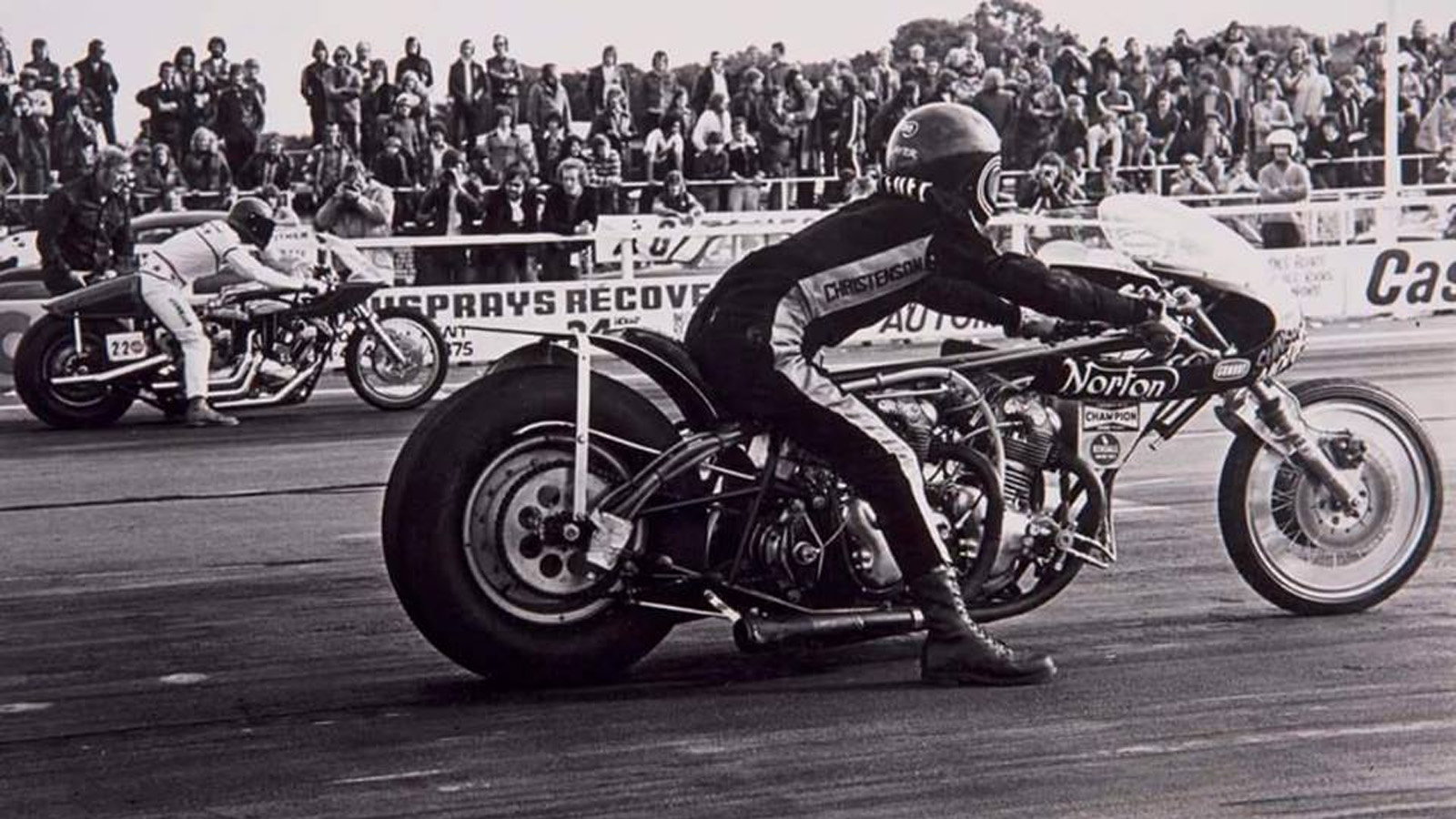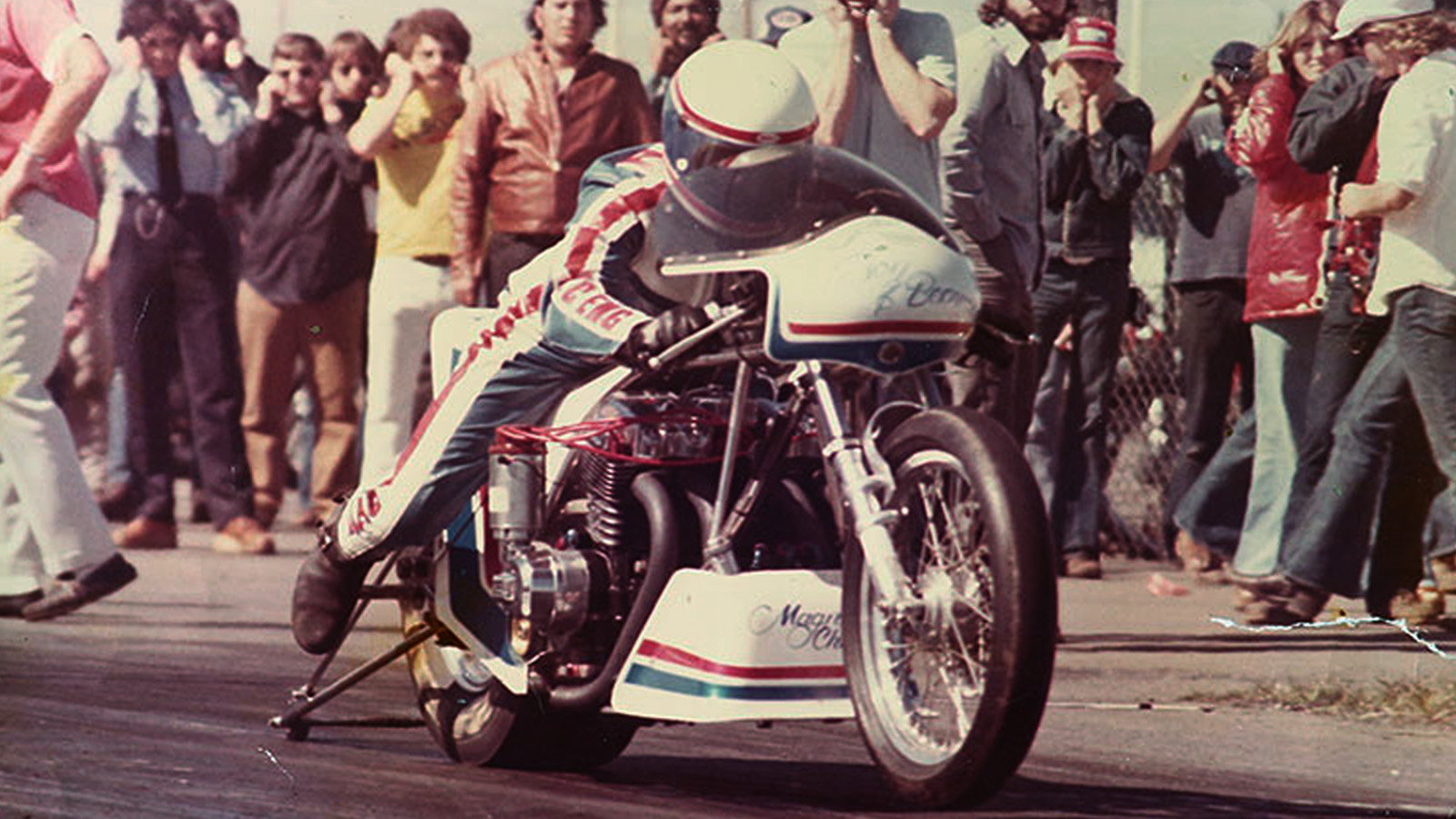Seeing Double: 1970s Twin-Engine Harley-Davidson Nitromaniac Drag Racing
Early Top Fuel drag bikes were called an “innovation comprised of many innovations.”




















Glory Days
The pioneers of Top Fuel motorcycle drag racing pushed mechanical boundaries to the limit during the 1970s. In what has become known as the 'glory days,' racers began squeezing two Harley-Davidson engines into one chassis. With bores stretched out to over a 100 cubic inches each, these nitro methane-fueled dual-engine bikes dominated the quarter-mile and helped to establish the legacy of Top Fuel drag racing.
Monster Knucklehead
Top Fuel dual-engine Harley-Davidson drag bikes all share a common ancestor. In 1953, Robert 'Bud' Schmitt conjured up the 'Monster' — a dual Knucklehead-powered, 80 cubic-inch each, four-carburetor, methanol-guzzling racing beast. Schmitt consistently posted 130 mph, ten-second runs at Chicago's Maremont Speedway, despite the engines being coupled together with a crude assembly of drive chains.
>>Join the conversation about twin-engine drag racers right here in HDForums.com.
World Record
In 1954, Schmitt took the 'Monster' to the Bonneville Salt Flats. He laid down a blistering one-way pass of 157.20 mph on the salt. Unofficially, he capped Rollie Free's Vincent-powered pass of 156.58 mph, set in 1948 when Free captured a world speed record of a 150.31 mph in combined passes. Due to mechanical difficulties, Schmitt was unable to complete his two way run for an official record.
>>Join the conversation about twin-engine drag racers right here in HDForums.com.
Dual Triumph
At the time, dual-engine drag bikes were new phenomena in America. But British racers had been cobbling together engines since the early 1950s. Legendary racer Bud Hare built the first official stateside dual-engine racer called 'Dübble Trübble' in 1956. The Triumph-powered machine dominated drag strips during the 1950s and posted a top speed of 142.38 mph at the Santa Ana drag strip.
>>Join the conversation about twin-engine drag racers right here in HDForums.com.
Sanctioned Races
During the 1960s, motorcycle drag racing matured. Events became sanctioned and in 1970 the NHRA decided to absorb motorcycle racing into its organization. The new motorcycle operating rules were written by Hot Rod magazine Editor Bob Greene and AMA Referee Earl Flanders. The 'First Annual U.S. Fuel and Gas Motorcycle Nationals' was held in March of 1970 at Irwindale Raceway in Southern California.
>>Join the conversation about twin-engine drag racers right here in HDForums.com.
Follow Suit
Dual-engine drag bikes enjoyed a decade of dominance. From 1970 to 1979, almost all Top Fuel bikes had at least two engines. Racers running British-made motors soon learned that it took two motors to outrun the large displacement single-engine Sportsters. As is always the case with racing, the rise of fast British dual-engine machines promoted the introduction of dual-engined Harley-Davidsons.
>>Join the conversation about twin-engine drag racers right here in HDForums.com.
Monster Drag
Among the many legendary names of Top Fuel motorcycle racing, Danny Johnson stands out. In 1972 he debuted 'Goliath' at the Atco Dragway in New Jersey. With Johnson at the bars, the 460-lbs monster posted times in the mid-eight seconds on the quarter-mile. Influential motorcycle journalist, Sandy Roca, described it as a “Mind Shredder, two Harley-Davidson engines, each stretched out to 107 cubic inches.”
>>Join the conversation about twin-engine drag racers right here in HDForums.com.
Indy Crash
Goliath was destroyed in a racing accident in 1973 at Indianapolis Raceway Park — now Lucas Oil Raceway. Renown motorsports photojournalist Steve Reyes captured Goliath's final moments. The front wheel became detached and Goliath hit the wall, launching the tank into the air, spewing its nitromethane contents. Johnson walked away from the crash and promptly began working on Goliath II.
>>Join the conversation about twin-engine drag racers right here in HDForums.com.
V-Twin Contender
Tom Loughlin Jr., writing for Dragbike! magazine in 1974, described Goliath as “an innovation comprised of many innovations.” Despite the praise, fellow racers and officials were initially skeptical of Johnson's idea. Even with problems with primary chain breakage, due to the 214 cubic inches of nitro fired V-Twin power, Johnson went on to prove his critics wrong and cemented twin-engine Harley-Davidsons as a viable Top Fuel contender.
>>Join the conversation about twin-engine drag racers right here in HDForums.com.
Decade of Dominance
In 1977, Ron Teson created a drag bike that changed everything. Teson's bike was a single-engine Honda 750 with fuel-injection and a roots-type supercharger. It was faster, and more importantly, quicker than any double could hope to achieve. With the Motor Company in financial trouble, there was no sponsor money for a single-engine supercharged Harley-Davidson. A decade of dominance drew to a close and double V-Twin dragsters faded into the history books.
>>Join the conversation about twin-engine drag racers right here in HDForums.com.
For help with your maintenance and repair projects, please visit our how-to section in the forum.

